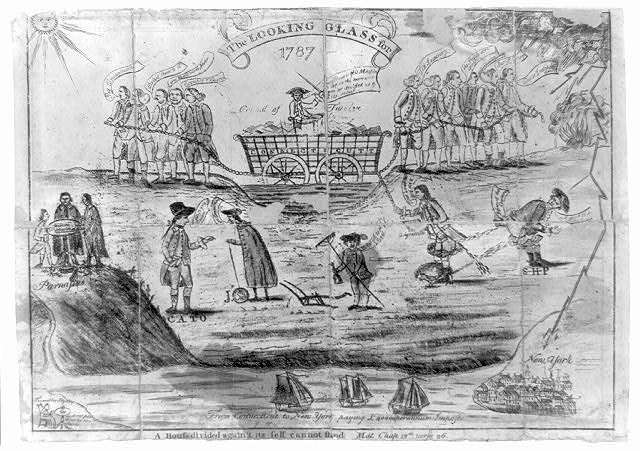Amos Doolittle’s engraving ‘The Looking Glass for 1787. A House Divided Against Itself Cannot Stand’ draws viewers in with its strong contrast between a clear sky with a bright shining sun and dark storm clouds. Amos Doolittle was a printmaker and engraver from Connecticut who created this piece to show the great divisions between different political parties in the United States at that time. By illustrating this, he was hoping to reflect on how dangerous these divisions were, especially for such a young country, and the need for unity.
During this time, the Constitution had not yet been created, and the country was governed by the Articles of Confederation.The states held most of the power and there was almost no central government. Because of this, the country quickly faced issues with the economy, as seen with events like Shay’s Rebellion in 1786. To discuss and hopefully fix these issues, delegates decided to meet in Philadelphia in 1787 to revise the Articles of Confederation. This meeting was called The Constitutional Convention, and it resulted in the creation of a new document, the U.S. Constitution, and “discussed the power and election of the executive, the judiciary, the method of ratification, and the powers of Congress” 1 With the new Constitution, there would be a stronger federal government. But this led to divisions, as seen in Doolittle’s piece. On one side were the Federalists, who were supportive of the new constitution and on the other side were the Anti-Federalists, who were worried it would give the central government too much power and take away individual rights. Anti- Federalists argued that “some mechanism was needed to prevent the states from being swallowed up by federal judicial overreach.” 3
Looking deeper into Doolittle’s, ‘The Looking Glass for 1787. A House Divided Against Itself Cannot Stand’ there is a great amount of symbolism that reflects the theme of the piece. In the center, there is a wagon that is sunken into the ground and is being pulled into two different directions by groups of men. One side is the Federalists, and the other is the Anti-Federalists. The wagon represents the United States and its government, which is sinking into the ground due to being pulled apart. This is a strong illustration of the tug-of-war battle that is happening because of opposing viewpoints regarding the new constitution. On the one side behind the Federalists, there is bright sunny weather where the other side behind the Anti-Federalists, depicts a dark storm. This contrast shows the growth that the country would have under a strong federal government and the tragedy that could unfold if the country continues without one. Because of this theme, it can be concluded that the piece is in support of the federalists and the new constitution.
Another piece of imagery that supports the theme of division preventing the country’s growth is the mountain that is labeled “Mount Parnassus”. In the Greek mythology story of Delphi and Parnassus, they were described as “landscapes in which tensions between wildness and civilization—a polarity at the heart of the culture of the polis—could be narrated, enacted, and organized.”2 Mount Parnassus represented wisdom and harmony in Greek mythology and in Doolittle’s piece, represents what the country would look like if the federalists ideas became reality. As the characters on the mountain are elevated and under the sun, it gives a clear representation of how the ideas of the Federalists are a better route for the young United States.
Amos Doolittle’s engraving, ‘The Looking Glass for 1787. A House Divided Against Itself Cannot Stand,’ is a powerful representation of the extreme political divisions within the United States during its beginning years. The piece argues for unity which would be found with a strong central government, as opposed to a weaker one leading to chaos and ruin. This theme of division was present in 1787 but can also be seen throughout American History. The Civil War, 74 years after Doolittle’s piece, is a clear example of two sides of the country not being able to find unity, leading to war with each other, which is exactly what Doolittle was warning against. This theme of division is also present today as politics cause deeper divisions between Americans, as seen with the January 6, 2021 attack on the Capitol. Two political sides were not able to overcome their differences and find unity, leading to violence. These examples show that Doolittle’s piece, ‘The Looking Glass for 1787. A House Divided Against Itself Cannot Stand’ is timeless throughout history as it continues to warn against political divisions.
[1] Gatica, Obed Frausto. “Federalist and Anti-Federalist: Two Divergent Concepts of Politics.” Studia Philosophica Wratislaviensia 14, no. 1 (January 29, 2019): 129–43. https://doi.org/10.19195/1895-8001.14.1.9.
[2] McInerney, Jeremy. 1997. “Parnassus, Delphi, and the Thyiades.” Greek, Roman and Byzantine Studies 38 (3) (Fall): 263-283. http://tricountycc.idm.oclc.org/login?url=https://www.proquest.com/scholarly-journals/parnassus-delphi-thyiades/docview/229179929/se-2.
[3] Moore, Tyler. “Trimming the Least Dangerous Branch: The Anti-Federalists and the Implementation of Article III.” SSRN Electronic Journal, 2020. https://doi.org/10.2139/ssrn.3679957.
